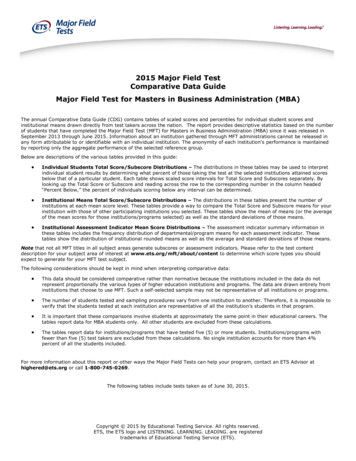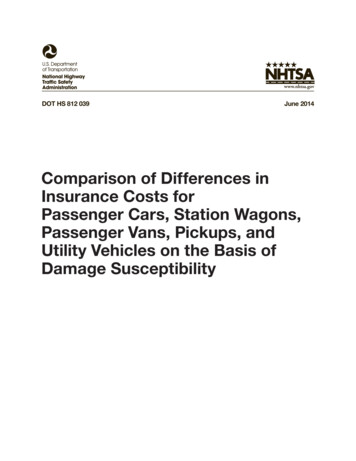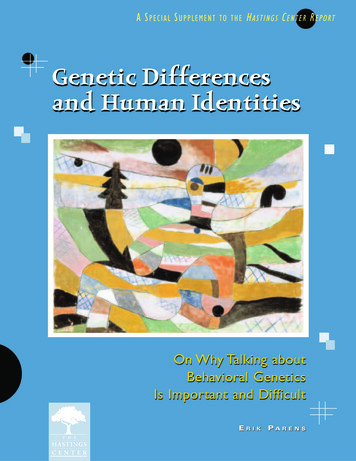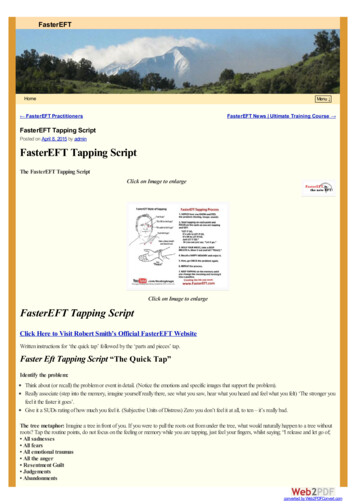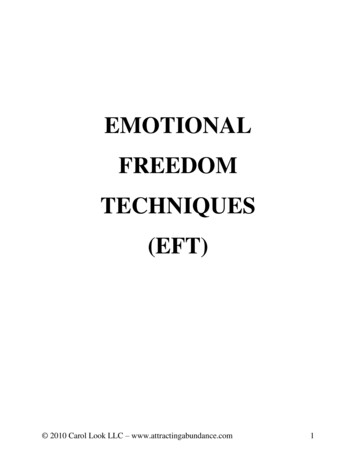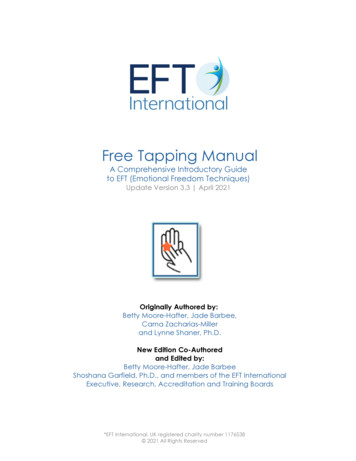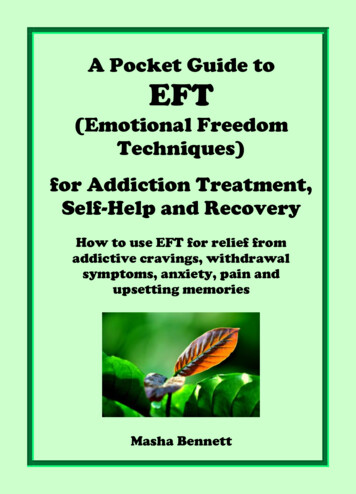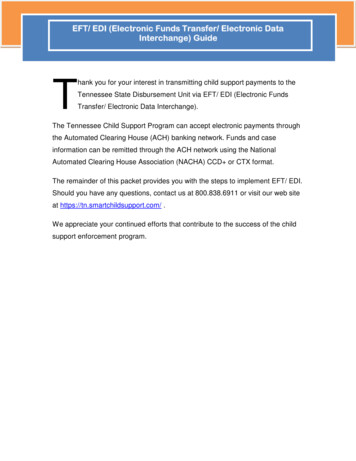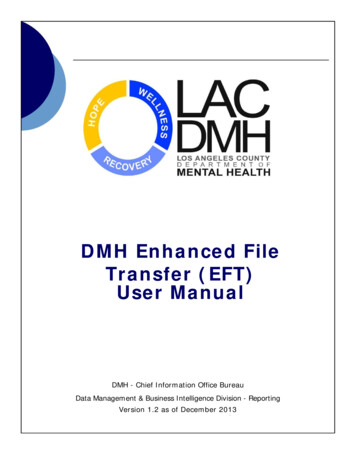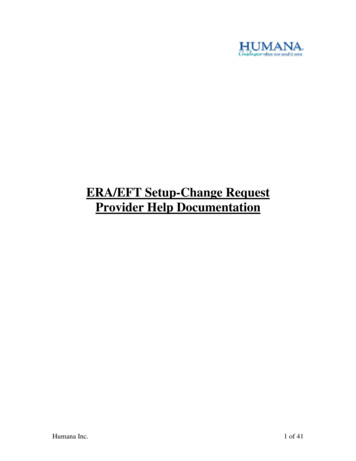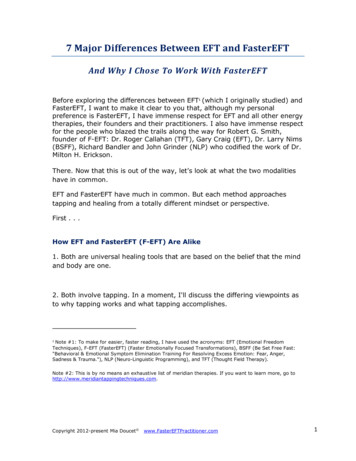
Transcription
7 Major Differences Between EFT and FasterEFTAnd Why I Chose To Work With FasterEFTBefore exploring the differences between EFT1 (which I originally studied) andFasterEFT, I want to make it clear to you that, although my personalpreference is FasterEFT, I have immense respect for EFT and all other energytherapies, their founders and their practitioners. I also have immense respectfor the people who blazed the trails along the way for Robert G. Smith,founder of F-EFT: Dr. Roger Callahan (TFT), Gary Craig (EFT), Dr. Larry Nims(BSFF), Richard Bandler and John Grinder (NLP) who codified the work of Dr.Milton H. Erickson.There. Now that this is out of the way, let’s look at what the two modalitieshave in common.EFT and FasterEFT have much in common. But each method approachestapping and healing from a totally different mindset or perspective.First . . .How EFT and FasterEFT (F-EFT) Are Alike1. Both are universal healing tools that are based on the belief that the mindand body are one.2. Both involve tapping. In a moment, I'll discuss the differing viewpoints asto why tapping works and what tapping accomplishes.1Note #1: To make for easier, faster reading, I have used the acronyms: EFT (Emotional FreedomTechniques), F-EFT (FasterEFT) (Faster Emotionally Focused Transformations), BSFF (Be Set Free Fast:"Behavioral & Emotional Symptom Elimination Training For Resolving Excess Emotion: Fear, Anger,Sadness & Trauma."), NLP (Neuro-Linguistic Programming), and TFT (Thought Field Therapy).Note #2: This is by no means an exhaustive list of meridian therapies. If you want to learn more, go ht 2012-present Mia Doucet www.FasterEFTPractitioner.com1
3. Both are relatively painless. Any emotional discomfort is minimal and lastsonly a few moments. There is no need to relive all of the horrid details ofearlier experiences that shaped our lives. Even if it does hurt, it’s no worsethan what we are doing to ourselves in our heads on a consistent basis. Donecorrectly in a session, a client relives the bad memory for the very last time.4. Both approaches address the natural resistance that most people have togiving up familiar patterns and belief, although they do so in dramaticallydissimilar ways. I'll have more to say about that in a moment.5. Both have "stunning" success rates and produce profound and lastingresults. Now, here’s one of the reasons for my bias: EFT produces lastingresults if you get to all the aspects associated with a troubling experience.F-EFT produces results because you're changing how the subconscious mindencodes, processes and reproduces events from the past. You’re not justdoing away with a negative experience, but rather you’re getting rid of theway your mind keeps re-creating the problem.6. Both empower people to take responsibility for their own healing, to tapon their own and not become dependent on therapists or practitioners fortheir healing.7. Both were born of genius and gutsi. I think of genius as the ability to seethrough and simplify the complex. Most people would agree it takes guts tobe able to challenge and break away from accepted belief systems, riskingthe scorn of one’s mentors and peers.Gary Craigii, founder of EFT, said he looked forward to a time that EFT wouldbecome obsolete because an even more elegant way of releasing issues hadbeen discovered. Then, he said, he could retire. I don’t know if F-EFT is the“more elegant way” he referred to.Let’s see what you think . . .Copyright 2012-present Mia Doucet www.FasterEFTPractitioner.com2
How EFT and Faster EFT DifferDifference #1: Core PrinciplesEssence of EFTThe EFT I studied is based on the belief that “The cause of all negativeemotions is a disruption in the body’s energy system.” It is “a literaldisruption in the energy flow.”According to EFT, memories may contribute but are not the direct cause ofthe negative emotions. The cause is the emotional charge or disruption.When the energy system is disrupted, we experience physical, mental oremotional symptoms.Gary Craig was objecting to common practices in conventional psychotherapy, which believes that memories are the cause of our problems. Inorder to treat a person, traditional therapy requires a person to relive thememory of an emotionally painful event in vivid detail. (Often withoutresolution, I might add.)Having studied various forms of psychotherapy in the past few decades,including an intensive three-year Gestalt Therapy practitioner program . . .and having spent over 100,000 in pursuit of relief from the pain of my ownsad past, I can assure you that traditional therapy is painful and does notnecessarily cause positive changes or make one happier in the process.So, when I first encountered EFT and finally began to see results in my ownlife, I totally bought into the belief that the reason we have problems is adisruption in the energy system. And that tapping works because it clears thedisruption by restoring the free flow of energy. It made all the sense in theworld. And I was deeply appreciative of Gary Craig’s insights and brilliance.And then . . . along came Robert Smith.iiiEssence of FasterEFT in a NutshellRobert's FasterEFT system operates from the belief that there is nodisruption in the energy system. In fact, he says, that is physicallyimpossible because if our energy were blocked with a negative emotion suchas anger for example, we would be stuck with anger. But, if in the nextmoment we can experience a positive emotion such as love for a small baby,then obviously the meridian isn’t blocked.Copyright 2012-present Mia Doucet www.FasterEFTPractitioner.com3
“It is not a disruption but a creation. It's about subconscious imprintsrecorded in the brain in childhood and our emotional attachments to whatwe have perceived.” Robert G. Smith, Founder, FasterEFTIf the cause of all negative emotions is a disruption in our energy system,then that means something inside of us is broken . . . something isn'tworking correctly. But, Robert insists, there are no broken people. All of usare successfully producing whatever it is we know how to produce based onwhat we have encoded within us. F-EFT puts a big emphasis on empoweringourselves by taking responsibility for everything that we create in our lives. Ifwe have the power to create it, then we have the power to change it or cure it.CHILDHOOD IMPRINTSThe source of our problems, he says, is birth! From the moment of birth(indeed, from the moment of conception) we're recording our experiences ofthe world as subconscious imprints in the brain. We have problems becausewe were born into a world where the people around us had problems, and welearned how to cope . . . from them.He teaches that the real cause of all our problems is perception, meaningthat we see and interpret what’s happening to us now through the filters andrecorded information from our past. We “know” how to interpret and dealwith what’s happening to us now based on what we learned from pastmemories and references.IT’S A CREATIONThe past does not exist . . . it's over. However our past seems real to usbecause of the emotional charge that is still present when we rememberthings. The future likewise doesn't exist, except that we take our emotionalprogramming from our past experiences and project it onto the future.Nothing is real except the present moment. All else is re-creation, based onwhat is in the subconscious mind.While EFT treats physical, mental and emotional symptoms as a disruption inthe energy system, F-EFT treats these symptoms as a skillful creation of thesubconscious mind. We're doing something right in order to create and recreate an emotion over and over again. We're doing something right in orderto have a problem and in order to keep producing it. If we’re doingsomething right, then we are not broken, we are skillful.Copyright 2012-present Mia Doucet www.FasterEFTPractitioner.com4
“You’re not broken, you’re doing something right. You’re successfullymanifesting what you have been imprinted with. If you’re the creator ofyour memories, you can change your life by changing your memories.” Robert G. Smith, Founder, FasterEFTIf our subconscious is the cause of our own problems, then we can addressthe whole subconscious system that produced those problems. Here we seethe influence of Dr. Larry Nims and BSFFiv.Our task as F-EFT practitioners is to figure out what people are doing insidetheir mind to create, manifest and produce the problem. I’ll have more to sayabout that in the discussion of the role of NLP (next up).IT SEEMS REAL BECAUSE OF THE PHYSICAL REACTION“Stress is the body's reaction to negative perceptions.” Since the mind andthe body are one, our thoughts manifest as symptoms or emotions in thephysical body. Whatever we think, our body naturally follows. It’s thephysical manifestation that makes it seem real.This means that at any moment, you and I can create sadness or anger if weknow how. We just have to think a sad or angry thought. Our mind willtrigger our body and make it seem real somewhere in the body.IN ROBERT’S WORDS“Both systems are operating from two different models of the world. Onebelieves that ‘energy is out to get you.’ The other is, ‘you’re creating theenergy and you can change how you feel. You can change your mind. Youcan change your life.’”Now get this . . .Where EFT says that our problems are caused by an energy disruption, F-EFTsays what we want to do is create a disruption in the communication system.We want to temporarily disrupt the message of stress from reaching thebody. When we create a disruption, then we create changes.So the tapping actually breaks the pattern that has been creating chaos inthe body's central nervous system. This causes a positive mind/body shift.Difference #2: The Role of NLP (Neuro-Linguistic Programming)Copyright 2012-present Mia Doucet www.FasterEFTPractitioner.com5
In simple terms, NLP is the study of how we think, how we structure ourthoughts, how we communicate, and how we internally process ourexperiences.While Gary Craig studied NLP, its influence is not nearly as evident in EFT asit is in F-EFT.NLP is a major component of F-EFT. Its ultimate goal is to change the pastand the future through restructuring a person’s thinking in the present.INTERNAL STATES OF MINDSo, the F-EFT emphasis is on the structure of the thinking and the structureof the problem itself. How does the person internally represent and hold inmemory the things that happened in his past? How does she processthoughts and memories (visual, kinesthetic, auditory) of the things thathappened to her? And how do they repress or replay them in their minds?What are they doing inside their mind to keep past memories alive and makethem seem real today?When we step into a person’s mind using the skills taught in NLP, we start tounderstand how they produce their world. And once we are able to accessthese internal states of mind it's easier to make the desired changes.TRANCEDon’t let the “t” word scare you. You and I automatically go into hypnotictrances many times each day. How many times have you had this experience. . . you’ve been driving your car and you are daydreaming, and you arrivehome safely? You know you’ve been on the road. You may even have beendriving in the dark. You know you must have stopped at red lights and stopsigns. But you have no conscious recollection of the drive. It's like your carknew the way and drove itself home. That’s what a trance is like.When we're feeling bad, we're slipping out of the present tense and into thatold, familiar, negative hypnotic state or trance. It takes no effort at all to getthere. Our unconscious takes over. That's how we keep the past alive. AsRobert says, "memories buried alive never die." (Until you aim at them andtap them away, of course.)When you look at Robert’s FasterEFT videos on YouTube you can actually seethe client go into a hypnotic trance. Sometimes their eyes glaze over as theperson relives a past experience. It’s like a past event has come alive again,in the present moment. You can see the emotion in their face and eyes andtheir whole physiology changes.Copyright 2012-present Mia Doucet www.FasterEFTPractitioner.com6
Whenever we are not fully engaged right here in the present, we are in atrance. These trances seem real but they aren’t, because only the presentmoment is real. The past is past and the future isn’t here yet.The moment we go back to any point beyond this present moment, it’s allmade up. We feel it to be true because we’re in a trance and experience realsensations in our body. Someone might have hurt you or me in the past, butit isn’t happening in the moment, except in our minds. And by the way, whenwe remember something and re-experience all of the details and pain, all ofthe actors in that memory are actually us. (The perpetrator isn’t here now.)This is why Robert says, “When you remember something from the past andit causes you pain, it’s now you doing it to you.”The effective practitioner is pulling the person in and out of the trance state.Into the trance, then back into the moment, into the trance, then back intothe present moment. Each time this happens, the practitioner is alloweddeeper access to the client’s subconscious model of the world, where theycan pull out interlocking threads."If we take control of our mind, we take control of our life.Otherwise, we train our children to have our problems." Robert G. Smith, Founder, FasterEFTDifference #3: Meridian TappingTapping works, no matter who does it, because it addresses the mind bodysystem via electrical impulses that travel along the meridian system.BUT HOW?Viewed from their two very different perspectives, tapping is effective forvery different reasons.EFT uses tapping to remove "static" from your electrical system. I think theEFT practitioner might say that the most powerful part of EFT is the tappingand the words that accompany the tapping.Not so with Fa
07.08.2015 · How EFT and Faster EFT Differ Difference #1: Core Principles Essence of EFT The EFT I studied is based on the belief that “The cause of all negative emotions is a disruption in the body’s energy system.” It is “a literal disruption in the energy flow.” According to EFT, memories may contribute but are not the direct cause of
